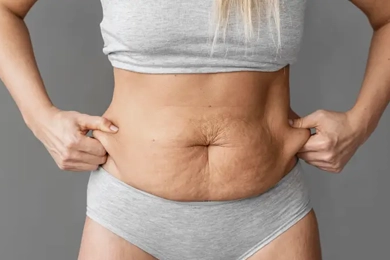
Abdominoplasty, also referred to as tummy tuck surgery, is a widely performed cosmetic procedure that can assist in attaining a more sculpted and flatter abdominal region.
Although the outcomes may be revolutionary, numerous prospective patients are apprehensive about the discomfort that accompanies the operation. This blog entry will discuss pain following tummy tuck surgery, including what to anticipate and techniques for alleviating discomfort throughout the recuperation period.
It is imperative to anticipate a certain degree of discomfort following a tummy tuck, given that the operation entails modifying the abdominal musculature and eliminating surplus skin and adipose tissue. Nevertheless, the intensity of pain differs among individuals and is contingent upon a multitude of factors, such as:
Although some degree of discomfort is unavoidable, there are a number of techniques that can be utilized to mitigate and control pain subsequent to tummy tuck surgery:
Although there may be some discomfort associated with tummy tuck surgery, the pain is typically tolerable with diligent follow-up and adherence to the instructions provided by your surgeon. By being informed of what to anticipate and adhering to post-operative instructions, one can facilitate a more comfortable and seamless recovery. It is advisable to seek personalized guidance and advice from a board-certified plastic surgeon concerning the abdominoplasty procedure and recovery at all times.
 10 Essential Facts About Tummy Tucks
10 Essential Facts About Tummy TucksAre you thinking of getting your tummy tucked but you have so many questions and worries? You're not by yourself. ...
 Vaser Abdominoplasty: A New Dawn in Tummy Tuck Innovation
Vaser Abdominoplasty: A New Dawn in Tummy Tuck InnovationAbdominoplasty, commonly known as a tummy tuck has long been a well-liked option for anyone hoping to get a more toned, flatter tummy. ...
 Is Tummy Tuck Surgery Painful? A Comprehensive Insight
Is Tummy Tuck Surgery Painful? A Comprehensive InsightMany people are drawn to the idea of getting a tummy tuck (abdominoplasty) in order to have a flatter, more toned abdomen. Prospective patients frequently struggle with worries about the discomfort of the su ...
 Can Diabetic Patients Have Tummy Tuck?
Can Diabetic Patients Have Tummy Tuck?Diabetes is a long-term medical illness that interferes with your body's ability to control blood sugar, or glucose. Type 1 and Type 2 diabetes result from the body's inability to use the insulin that is pro ...
 Understanding Tummy Tuck Surgery Risks
Understanding Tummy Tuck Surgery RisksThe goal of tummy tuck surgery, also referred to as abdominoplasty, is to remove extra skin and fat from the abdominal region to produce a flatter, more toned midsection. ...
 What Kind of Scar to Expect After a Tummy Tuck
What Kind of Scar to Expect After a Tummy TuckTo get a flatter, more toned abdomen, are you thinking about having a tummy tuck? It's important to realize that tummy tucks come with some degree of scarring even though they can produce noticeable aestheti ...
 What Are The Factors Affecting Tummy Tuck Prices?
What Are The Factors Affecting Tummy Tuck Prices?Abdominoplasty, sometimes referred to as a tummy tuck surgery, is a common cosmetic operation that can help people get a flatter and more toned midsection. Yet, depending on a number of variables, the price ...